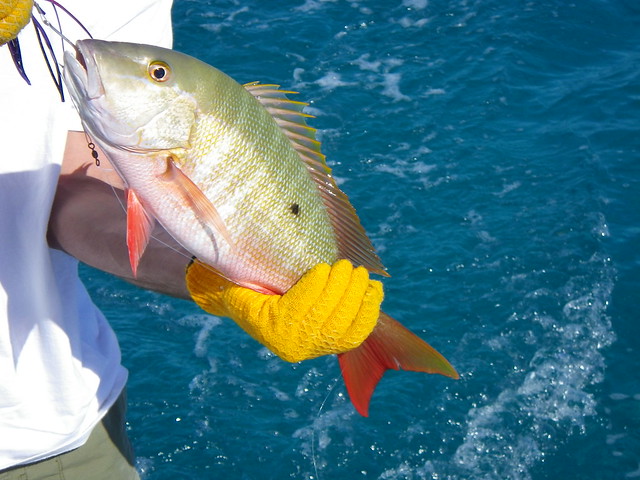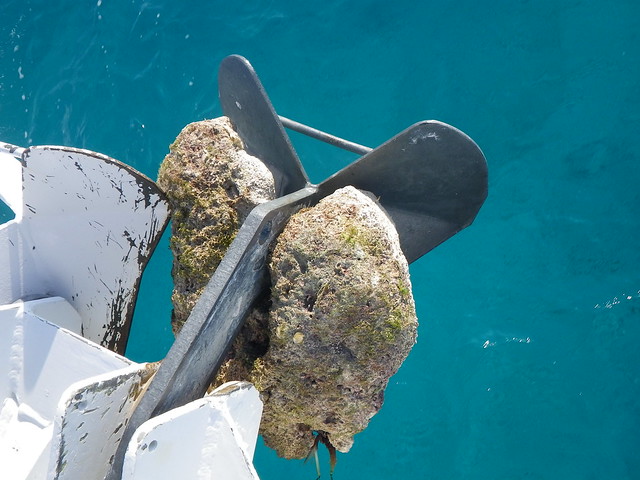We are nearing the end of our three-month stay in the Bahamas. Therefore, we are evaluating our experiences here and thinking ahead to future excursions. As the Galley Officer, I am responsible for planning and executing meals and snacks for six (or seven…) while away from posh U.S. grocery stores like Publix and Whole Foods. I tried to plan ahead before we left, not knowing what I would be able to find once we entered unfamiliar territory. I knew there was a “real” grocery store in Marsh Harbor, Great Abaco, and the guide book had ads for stores along the way, but almost everything in island stores must come by boat, so I figured the choices would be fewer and more expensive. I was right.
First, let me admit that there are two ways to approach provisioning. The eat-like-the-locals crowd might argue that people have to eat everywhere on planet earth, so wherever you go, you will be able to find food, and that sampling local fare is part of what makes cruising an enjoyable cultural experience. The second crowd, the bring-what-you-like folks might argue that sampling local fare is well and good, but when you want something special from home, you better have it with you or prepare to pay an arm and a leg to get it. Most people will fall somewhere between the two extremes, but we now lean more toward the “Bring It” rather than “Find It” mentality.
Our family made several diet changes awhile back, some of which require a lot of whole, raw materials, and a lot of time, fuel and energy. We basically eat nothing processed, as much organic/local produce as possible and pastured/free range meat and eggs and raw dairy when we can find it. Sometimes living on a boat makes this job easier (most cruisers figure out how to bake their own bread, for example), but other times, we are stuck with dried or canned goods that we would much rather find fresh. While it is true that people have to eat everywhere in the world, we do not think that all diets were created equal. The baked goods in the Bahamas, for example, are all made with white flour and white sugar, two things we avoid as much as possible. Pasta, rice and flour in the stores are almost always white as well. If we want to eat whole grains, we have to bring them ourselves and this we do in the form of wheat berries and oat groats that I grind on demand. These are not supplies you will find in even the best grocery stores, but things that must be ordered through health food stores or co-ops like Bread Beckers or Wheat Montana.
Other things, like local produce, we are happy to buy. I’ve never seen such large, beautiful cabbages as they have on Great Exuma. Depending on where you are in the world, though, the selection is likely to be limited. We compensate for this by bringing canned, dried, or frozen goods that are sometimes available in stores, but often more expensive. Other things that fall into the “available but costly” category would be condiments, quality snack foods (especially good when underway), nuts, and other supplies for baking. Some things we are required to buy fresh, like eggs, butter, milk, and cheese. We have been pleasantly surprised to find really good imported cheddar from New Zealand here, for example.
Meat always poses a dilemma for cruisers. If you are good at it, fishing can be a good source of protein. If you have a sizeable freezer, stocking up on quality meats before leaving is not a mistake. Otherwise, you are at the mercy of whatever small grocery store you find and the packages of “mystery meat” they may sell there, or canned meats like tuna, salmon, chicken, and the old stand-by, SPAM, which Jay likes and I refuse to eat. His protein needs exceed mine, so while beans could easily form a staple in my diet, Jay really needs meat to feel satisfied. We packed the freezer and don’t regret it.
I was happy to discover that I didn’t over-provision for this trip. I ran out at the last minute and bought extras of favorite health-store items like all-natural toothpaste and pure liquid castile soap and don’t regret it for a minute. My crazy bulk-buying at Costco paid off as well, and the only thing I might to differently is to buy more of the things we are running out of, like maple syrup, paper towels, nuts and whole-wheat pasta. When I do shop, I always have sticker shock in the checkout line. I would say the grocery bill here in the Bahamas is double what it was in the U.S. and that is without buying the organic products I am used to, and cutting out extras like chips, ice cream, yogurt, and lunch meats. And what passes for a grocery store in the smaller settlements would make my friends back home laugh. I am happy to patronize these little shops which support the local economy, and have had lovely interactions with proprietors from Green Turtle to George Town, but it’s really not sustainable long-term.
Our decisions are colored by the fact that we view this not as a camping trip, but as a lifestyle, and also by the sheer quantity of food we must buy and prepare to feed a large family. For an adventuresome couple, eating whatever you find along the way might be doable, but for us, I need to know that my growing children will have a healthy breakfast every morning. Although I am cautious about giving provisioning advice to prospective cruisers, I offer this one thought: the reality is that living on a boat limits your space for storing food, so bring as much as you can of the things you feel you can’t live without, and be willing to try new things along the way.
For further reading on this topic you might like The Care and Feeding of Sailing Crew by Lin and Larry Pardy and Gourmet Underway by Robbie Johnson.


